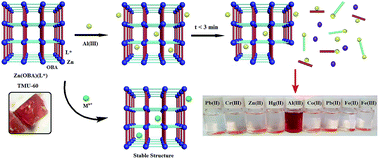Selective sacrificial metal–organic frameworks: a highly quantitative colorimetric naked-eye detector for aluminum ions in aqueous solutions†
Abstract
The detection, differentiation, and especially visual quantification of target compounds are important and interesting challenges for researchers. The quantitative diagnosis of contaminants by the naked eye is the easiest and most practical method to identify pollutants. Here, we presented a new and innovative way to detect and estimate the amount of aluminum ions in aqueous and non-aqueous solutions using a unique sacrificial metal–organic framework. This unique MOF (TMU-60: [Zn(OBA)(L*)]·DMF, where L* is 5,6-dipyridin-4-yl-1,2,3,4-tetrahydropyrazine) exhibited special interactions with aluminum ions even at negligible ppb values (>500 ppb), leading to quantitative degradation and subsequently a solvent color change from colorless to red, which could be easily detected by the naked eye. Also, the exact determination of the amount and even the detection of its lower values were possible due to the turn-on fluorescence property of TMU-60 (its detection limit (LOD) is 100 ppb).



 Please wait while we load your content...
Please wait while we load your content...